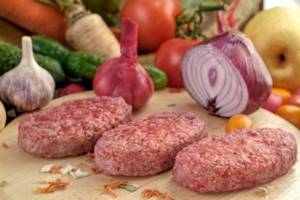Over the past decades, semi-finished products have firmly established themselves in our kitchens. They help save time and enable women to do more interesting things than daily cooking. However, most nutritionists in the world are very disapproving of processed foods. It is considered to be a junk food that can lead to obesity and other ailments. Is it so? And are there any advantages to semi-finished products? Let's try to figure it out.
What are semi-finished products?
Semi-finished products are products that are almost ready to eat and require only minimal cooking . Usually their preparation takes no more than 20 minutes. In Russia, the most popular are dumplings, dumplings and various pancakes with fillings.
The safest type of semi-finished products is frozen vegetables. They can become dangerous only if they are stored improperly for a long time and are repeatedly frozen and defrosted, and no store can allow this.
In addition, you can purchase a variety of meat and fish dishes, frozen gifts of nature, and ready-made lunches. Such products can be stored for more than three months, while their taste does not change, as does their attractive appearance. In many cases, raw materials for the preparation of semi-finished products raise questions, since manufacturers do not always choose the best . But they add special additives that allow the product to look attractive and not lose shape for a long time.

Semi-finished meat products Pelmeni

Frozen semi-finished products

Semi-finished dough products
Prices for semi-finished products can vary greatly. They depend on the quality of raw materials, the complexity of production technology and even packaging.
Convenience foods lead to weight gain

Scientists from the USA prepared the results of another study. It talks about how people get fat on processed foods. Scientists conduct an experiment. They selected 20 completely healthy people (10 men and 10 women) and put them on a special diet for 28 days.
For the first 14 days, people ate highly processed food. Then the diet changed dramatically and people were only allowed to eat minimally processed foods. In both cases, the experiment participants were able to eat as much food as they wanted.
The results were incredible. On the highly processed food diet, people ate 500 more calories per day than on the minimally processed food diet—about 3,000 calories versus 2,500. Over 14 days on the processed food diet, people gained an average of 1 kilogram of weight. Switching to less processed foods allowed them to lose 1 kilogram of weight.
Did you know that you can lose weight only by thinking about it?
Too many calories and weight gain were observed even when both diets contained the same amount of proteins, fats, carbohydrates, as well as various beneficial microelements.
Are they useful?
In modern media you can find many convincing arguments why processed foods should not be consumed under any circumstances? But are they any use? We answer: undoubtedly, there is. And the first thing that comes to mind is the liberation of women from kitchen duties. Today, in order to prepare a chicken cutlet, the fair sex does not have to run to the barn to catch the chicken, cut it, pluck it, carve it, prepare minced meat and, finally, fry it. Now this whole process takes a few minutes, and the woman has time for herself and her family.

Cutlets
The choice of semi-finished products is so wide that you can easily prepare both the first and second, and an excellent dessert. Compared to other “fast food”, they, of course, win, surpassing dry sandwiches or street hot dogs in health. But semi-finished products also have significant disadvantages.
Why are processed foods harmful to health?
Hemorrhoids kill the patient in 79% of cases.
Among the main disadvantages of semi-finished products, the following deserve mandatory mention :
- Too high calorie content. Indeed, most processed foods contain large amounts of fat and carbohydrates. This is explained by the fact that high-quality meat is rarely used for semi-finished meat products; offal, fat, skin and various trimmings are often added to them, which makes the product too fatty. Such food not only negatively affects your figure, but can also lead to increased cholesterol levels.
- Adding vegetable proteins to meat products. Very often, product packaging only indicates the total amount of protein, without specifying its origin - so you can buy soy or something else under the guise of meat.
- Too much salt, which puts stress on the kidneys. Indeed, some unscrupulous manufacturers mask the not-so-natural taste of the product with salt.
- Excess of flavoring and aromatic additives. Most of them are safe and can be used in cooking, but moderation must be observed in everything, which is not achieved by all manufacturers.
- There is always a possibility that a semi-finished product is contaminated with pathogens, and if it was stored incorrectly, which is not uncommon in our stores, it can become a source of disease.
In addition, we must remember that instant porridges are made from processed and scalded grains, while whole grains are much healthier. We also draw your attention to the fact that it is recommended to fry many semi-finished products for cooking - and this process does not add any usefulness to any dish .
If a product has too many spices, this is the first sign that something is wrong with it. Manufacturers try to drown out the unpleasant or unnatural taste of the product with seasonings.
The worst of all are instant food products, including noodles, soups and purees, which you just need to pour boiling water over . Such dishes contain practically no vitamins and other useful substances, but they contain a lot of fast carbohydrates, flavors and flavoring additives.
Canned food
Canned food is generally considered evil in the flesh - they, of course, contain solid preservatives. But the truth, as usual, is somewhere in the middle. Eating only canned food, especially meat or fish, is, of course, worse than buying fresh steak and vegetables.
Nevertheless, from time to time it is not at all dangerous to use canned food, rather the opposite: from beans collected in season and straight to the processing plant, you will get much more benefits and taste than from the same fresh ones, but arrived at the store thousands of kilometers away and unknown how it was stored.
TIP: If possible, rinse the contents of tin packaging to rid food of excess salt, the most popular preservative in human history.
WH'S PICK: Diced Pomito Tomatoes. Very useful if you need to make a diet sauce for pasta, bruschetta with herbs and cheese, or gravy for meat. And no tediousness with finding delicious tomatoes, washing and blanching - tomatoes, strengthened under the Italian sun, are at your disposal all year round.

Poor quality ingredients are the main danger!
What's the worst thing about processed foods? These are not flavorings or flavor enhancers at all, most of which have passed laboratory tests and are absolutely safe for humans. These are not the legendary GMOs, the harm of which not a single scientific organization in the world can prove, and not even the high calorie content, which can be limited by reducing portions. The main enemy is low-quality ingredients, which not a single manufacturer of semi-finished products is in a hurry to warn about .
The insidiousness of delicious-looking dishes is that even laboratory tests cannot always determine what is included in their composition. It is clear that a very rare manufacturer can afford to use high-quality meat to prepare cutlets, and the cost of such a product will be too high for most consumers. Therefore, a variety of trimmings and offal are used. But some unscrupulous enterprises may use expired products or so-called food fillers, which are not human food at all.
The average person will never be able to taste what is added to a dish - sugar or cheap corn syrup, which can lead to metabolic imbalance and imbalance of sugar and insulin in the blood.
A very dangerous ingredient in processed foods is trans fats, which lead to vascular blockage and cardiovascular diseases. as well as obesity . If you see the words “hydrogenated” or “fractionated” fat on the packaging, it is better to avoid such a product.
Carefully study the product packaging and its composition and do not forget that a high-quality semi-finished product cannot be cheap.
World Health Organization on processed foods
As you know, the World Health Organization is very seriously concerned with nutrition issues, which are very closely and directly related to health issues, both in countries with a high level of development and high per capita income, and in developing countries. Therefore, at the UN in 1963, the FAO/WHO International Commission on Codex Alimentarius was created (Food and Agriculture Organization of the United Nations, or Food and Agriculture Organization (FAO) - an international organization working under the auspices of the UN to implement a code of standards and regulations for food products).
Codex Alimentarius, or the Food Code, already in 2012 united 186 individual countries of the world and the European Union in the commission. In addition, 215 different organizations, including intergovernmental, non-governmental, and various UN bodies, received observer status.
The Food Code's food standards and regulations apply to all major foods produced around the world, including processed and processed foods, as well as unprocessed foods.
If we look at history, we can find out that the Codex Alimentarius Commission was created under the influence and insistence of the pharmaceutical industry as a follow-up to the resolutions that were adopted back in 1961 at the Sixteenth Assembly of the WHO . the standards developed in the Austro-Hungarian Empire between 1897 and 1911 for a huge number of food products . It was Austria that actively sought to create a European code and promoted this idea in every possible way (especially actively from 1954 to 1958 ), which in 1961 culminated in a resolution of the Council on Codex Alimentarius Europaeus , in which already existing standards were proposed for FAO and WHO.
It is very important that the modern Codex Alimentarius, that is, a set of international food standards, and its standards apply to almost all major types of food products, including raw foods, processed foods and semi-finished products. It is very important that the standards and requirements of the Code also cover those materials and components that can be used in the processing of any food products.
What aspects of food does the Codex Alimentarius, also known as the Food Code, cover? First of all, this is the quality of any and all food products, including nutritional and hygienic issues. In addition, great attention is paid to the use of food additives, microbiological regulations and requirements, the problem of pesticides and/or veterinary drugs that may remain in food, and the possibility of other contaminants present in food. In addition, the Food Code pays great attention to the forms of release of food products, the issues of appropriate labeling of each food product, as well as the tests and analyzes necessary to ensure complete safety.
As for the attitude of the World Health Organization to semi-finished products, it should be noted that infant formula, baby cereals, baby juices also belong to semi-finished products, but their quality is very high and guaranteed by the manufacturer, and also complies with all WHO standards and is completely safe even for infants in the first days of life.
As for slightly older children, WHO once again expresses concern about the high salt content even in those products that are intended for children. According to WHO experts, who are based on the results of numerous studies, children under two years of age should not add salt to their food at all, and for children over two years of age (toddlers), only half a gram of salt per day is enough.
WHO experts point out that many products that are used in daily nutrition already contain sodium chloride, that is, table salt, in their natural composition. Moreover, we are talking about such really popular products as milk or eggs, not to mention, for example, tomatoes. As for any semi-finished products, even those intended for the smallest children, they already contain a sufficient amount of sodium chloride, that is, table (kitchen) salt.
New WHO recommendations say that even for an adult, the daily salt intake should not exceed two grams, taking into account the hidden salt contained in prepared foods. Such careful use of salt will help to avoid many heart diseases and arterial hypertension (high blood pressure).
The World Health Organization is also extremely concerned about the very high consumption of sugar, including that contained in processed foods. And excessive sugar consumption is known to contribute to excess weight gain and the onset or development of obesity and/or diabetes.
According to WHO experts, sugar should not exceed 5% in a person’s energy balance, but in the modern world, with the current nutritional structure, the share of sugar can reach 15% (this is an average figure, which in reality can be significantly higher).
Experts say consumers almost never know how much sugar is in processed or processed foods. However, we are not talking at all about fructose, which is found in natural fresh fruits and vegetables.
WHO strongly recommends reducing your sugar intake by at least half - this will allow you to better control your weight and avoid many diseases, including such serious ones as obesity and diabetes.











